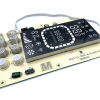
The structure and application of tension springs.
When designing the tension spring, the coil is tightly touched, the purpose is to promote the rotation and make the angle rebound. There are many options for the arm configuration, so that the spring can be fixed in different ways. For tension springs, the moment arm specifications that need to be considered include moment arm angle, equal moment arm length, and moment arm closing type. When the springs are straight or parallel on the same side, the arm angle is regarded as 0°, and the angle increases along the non-rotating direction. Force arm closing types include straight torsion, linear offset, hinged, short hook closing and hook closing. In order to meet the application requirements, the closing opening of the tension spring can be bent or distorted, and the closing opening may be made into a hook or a pull ring.
The orientation of the free arm of the tension spring includes: 90°, 180°, 270° and 360°. The double torsion spring consists of a set of right-hand rotating coils and a set of left-hand rotating coils. These coils are usually connected by the unclosed parts between the windings, and these coils rotate in parallel. This part needs to be designed separately, and the total torque is the sum of the coils at both ends.
Where are the tension springs mainly used?
When in use, the bottom part of the tension spring is often fixed to other places, which constitutes the phenomenon that other components rotate around the center of the tension spring. Once the other components start to rotate around the center of the spring, the spring quickly pulls the other components back to the original position, which will constitute a kind of rotational force, which changes the generated rotational force into the required resistance. In this way, the tension spring can be used to fix a certain device in a static way by storing or releasing this energy to achieve the desired effect.
Of course, if the place of application is different, the number of turns of the tension spring is also different. Therefore, a lot of physics and mathematics are touched here. After the resistance required to fix the equipment, the number of turns required for the tension spring is calculated. Moreover, in the calculation process, the rotation direction of the tension spring is designed according to the practical requirements of the application.
The orientation of the free arm of the tension spring includes: 90°, 180°, 270° and 360°. The double torsion spring consists of a set of right-hand rotating coils and a set of left-hand rotating coils. These coils are usually connected by the unclosed parts between the windings, and these coils rotate in parallel. This part needs to be designed separately, and the total torque is the sum of the coils at both ends.
Where are the tension springs mainly used?
When in use, the bottom part of the tension spring is often fixed to other places, which constitutes the phenomenon that other components rotate around the center of the tension spring. Once the other components start to rotate around the center of the spring, the spring quickly pulls the other components back to the original position, which will constitute a kind of rotational force, which changes the generated rotational force into the required resistance. In this way, the tension spring can be used to fix a certain device in a static way by storing or releasing this energy to achieve the desired effect.
Of course, if the place of application is different, the number of turns of the tension spring is also different. Therefore, a lot of physics and mathematics are touched here. After the resistance required to fix the equipment, the number of turns required for the tension spring is calculated. Moreover, in the calculation process, the rotation direction of the tension spring is designed according to the practical requirements of the application.






